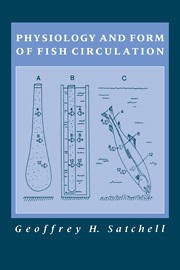Book contents
- Frontmatter
- Contents
- Preface
- 1 Introduction
- 2 The Heart
- 3 The peripheral circulation
- 4 The blood
- 5 Haemopoiesis and phagocytosis - the mononuclear phagocytic system
- 6 Circulation through special regions
- 7 Retial counter-current systems: flow–diffusion–concentration
- 8 Venous return and venous pumps
- 9 The autonomic nervous system
- 10 The response to exercise
- 11 The response to hypoxia
- 12 Myxine, a speculative conclusion
- References
- Appendix of popular and scientific names
- Index
8 - Venous return and venous pumps
Published online by Cambridge University Press: 05 February 2012
- Frontmatter
- Contents
- Preface
- 1 Introduction
- 2 The Heart
- 3 The peripheral circulation
- 4 The blood
- 5 Haemopoiesis and phagocytosis - the mononuclear phagocytic system
- 6 Circulation through special regions
- 7 Retial counter-current systems: flow–diffusion–concentration
- 8 Venous return and venous pumps
- 9 The autonomic nervous system
- 10 The response to exercise
- 11 The response to hypoxia
- 12 Myxine, a speculative conclusion
- References
- Appendix of popular and scientific names
- Index
Summary
Venous pressure
Venous pressures in fish are low and are often below or close to ambient (Table 8). Only in the hepatic portal system do they reach 10 mm Hg (Stevens and Randall 1967).
In mammals at rest, the kinetic energy of the blood in the veins is commonly a small proportion of the pressure energy. Even in the venae cavae and atria it is only 12%; in fish the very low, often subambient, venous pressures must imply that kinetic energy represents a larger proportion, and pressure energy a smaller proportion of the total. The return of blood to the heart is possible only because of the virtual absence of gravitational effects (Chapter 1) and because the ductus Cuvieri and the long veins, such as the caudal, cutaneous and lateral abdominal, have incollapsible walls and cardiac suction can lower the pressure at their central ends. Additionally, fish have a remarkable collection of auxiliary venous pumps which augment the pressure of outflows from, and steepen the gradient of, pressure across capillary beds remote from the heart. Two of these, the caudal heart and the portal heart of the myxinoids, are true hearts in the sense that their muscles serve only to power the pump. The others, such as the haemal arch pump, the branchial pump, and the so-called ‘cardinal heart’ of myxinoids, are propulsors, for they are powered incidentally by muscles which serve some other function such as locomotion or ventilation.
- Type
- Chapter
- Information
- Physiology and Form of Fish Circulation , pp. 126 - 140Publisher: Cambridge University PressPrint publication year: 1991



